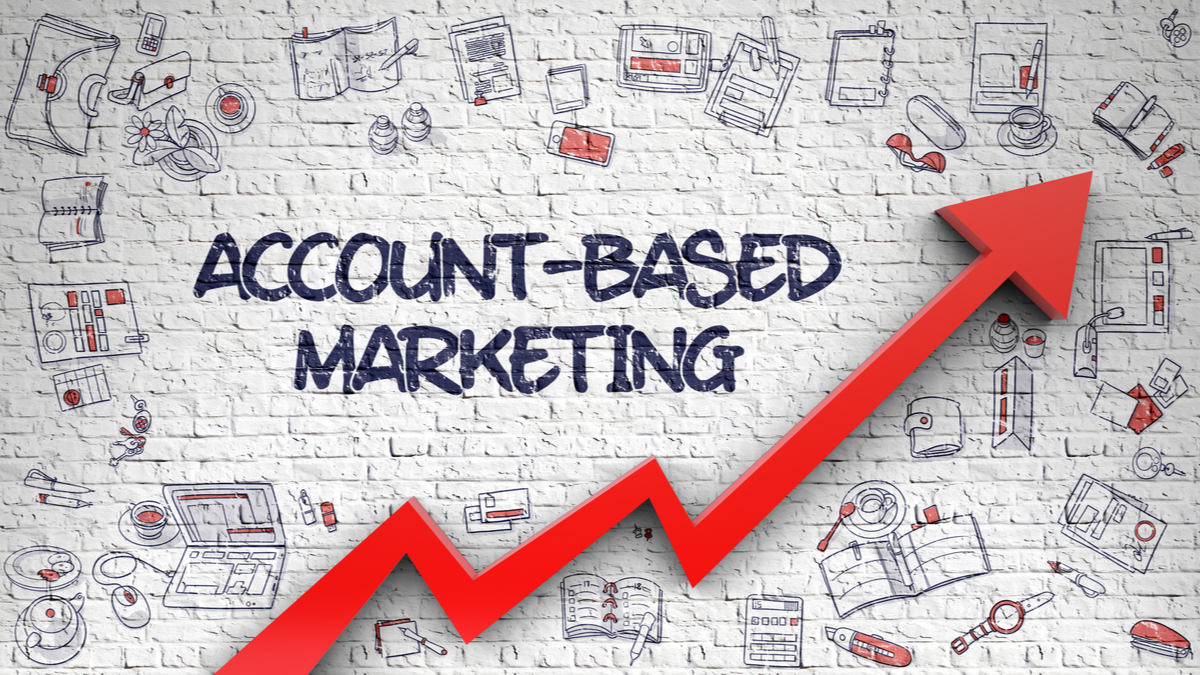The marketing landscape is constantly evolving. Trends come and go. There used to be a time when the marketing trend was all about catching as much attention as possible from a wide audience – much like a fisherman casting a huge net in the sea. The goal was to catch everyone in the target market. Now, this marketing technique isn’t necessarily wrong. However, for B2B companies, there’s an alternative method that might work better – account-based marketing (ABM).
The term ABM marketing was first coined by ITSMA in 2004. And it has been in practice among B2B vendors for several years. But it is only recently that it has gained serious attention from companies. In fact, according to SiriusDecision, more than 90% of marketers today believe that ABM is essential to B2B marketing. This means that if you’re a B2B company, you’re going to need to learn how to apply this marketing model to your sales and marketing plans.
What Is Account-Based Marketing?

Before we talk about the account-based marketing strategy, let’s first get a clear understanding of what it is. Account-based marketing is a marketing concept wherein the marketing team focuses all its effort and resources – content, events, and campaigns – on a specific customer, either potential or existing. That customer is going to be the entire market. Everything is highly personalized, designed to engage a specific account, catering to the specific characteristics and needs of the customer.
How exactly does the account-based marketing strategy differ from traditional marketing? As we’ve mentioned before, traditional marketing is done by trying to attract a wide range of potential customers, nurturing leads, and then narrowing your focus to a select few.
Account-based marketing, on the other hand, does everything upside down. With this strategy, you already narrow down your list to a select few. After identifying your target companies, you engage with them using highly targeted, personalized campaigns. From there, you build the foundation for a strong customer relationship that opens up new opportunities for your company to get new sales and grow.
According to some experts, it’s like “zero-waste” marketing because you only pursue good quality leads – companies that are most likely to buy your products or services. You use campaigns that are optimized to engage them and specifically cater to their needs. As the name already suggests, ABM focuses on accounts, not target markets or industries.
Benefits of Account-Based Marketing
Now that we’re clear about what the account-based marketing strategy is let’s talk about why it’s so beneficial to B2B companies.
Personalized Market Approach
When you’re selling to a business, it’s not unusual for you to be dealing with multiple buyers or stakeholders. It’s harder to connect with all of these decision-makers intimately when you’re sending generalized content. You won’t be able to address their specific needs. With an ABM campaign, you can customize your message to make sure that the individual and company-wide needs of the potential client are met.
Easier to See a Potential Return on Investment
Attributing new revenue to your marketing campaigns can be quite challenging for any company. With an account-based marketing strategy, you know which campaign was funded and the amount of money you earned from it. This allows the business (and upper management) to become more confident in the marketing team’s efforts, possibly even providing more resources to create better ABM campaigns.
You Spend Less Time on Marketing Campaigns That Don’t Yield New Business
We’ve already mentioned that ABM can be described as “zero-waste” marketing. With traditional marketing, you can spend money just trying to attract potential clients and waiting to see which ones will “bite.”
With an ABM campaign, you’ve already identified the biggest opportunities for your company and can focus your efforts on closing the sale. Moreover, you can use the same technique to act on new opportunities to upsell or cross-sell products and services to your existing clients.
Shorter Sales Cycle
There are several reasons for this. First, your sales team will not need to waste time filtering out poor-quality leads. Instead, they go directly after the most likely buyers of your company’s product or service. In addition, you are able to nurture the leads simultaneously. There’s no need to wait for the approval of various stakeholders, which saves you more time.
Improves Customer Retention
Having a good customer retention rate is the key to a successful business. Account-based marketing allows you to archive that as you’re able to provide an amazing customer experience. That is because you’re highly focused on your client’s needs. At every touchpoint along your customer’s buying journey, you provide value. You let them know how you can help make their business better by discussing their specific pain points:
You don’t give them generalized content. Your focus is on what you can do for them. Because of this, your existing clients don’t feel like they’re being sold to. They start to view your company more like a trusted partner who has their interests in mind. This increases the likelihood that they will renew their contract once it ends. It may even create opportunities for you to do cross-sales or upsells.
Create a Strong Alignment Between Your Sales and Marketing Teams
Typically, a marketing team is focused on just generating lots of attention for your brand in target markets and industries. They look for leads, and whatever they catch is thrown over to sales, which will be responsible for chasing said leads. Most often, these two teams are not aligned because their goals and their focus are not the same – the number of leads versus the quality of leads.
With ABM marketing, both teams work together, focusing on target accounts with their eyes on the same goal. According to Forrester Research, when these two teams are aligned, companies can expect a 32% increase in their annual revenue on average.

Account-Based Marketing Tactics for Launching a Campaign
Identify the Most Valuable Targets
As we’ve mentioned before, the ABM campaign is focused on accounts, not industries. In order to do that, you need to first figure out who your key accounts are. Key accounts are defined as companies that make up 20% of your customer base but are responsible for 80% of your total revenue. The same term can be used to describe prospects or potential companies that belong to that 20/80 ratio. In short, you need to look for companies that will be able to contribute the most revenue to your business.
The first step to doing this is by compiling firmographic data – like a demographic but related to companies. You’ll need data on company characteristics such as industry, number of employees, location, annual revenue, projected profit margin, and the likelihood of repeat business.
Your sales and marketing teams will need to collaborate in order to come up with this data and create an ideal customer profile or ICP. The ICP will show you the common characteristics of companies that will most likely buy your product and services. You can then use this to identify the best-fit accounts so that you can convert them into customers.
Map Your Target Accounts
Once you know who your target accounts are, you’ll need to get as much information on them as possible. This includes learning about the market dynamics, industry trends, growth drivers, competitors, needs, and current pain points. You also need to get a clearer picture of the organization in terms of its various stakeholders, influencers, and even the end-users (the people who will actually be using your product or service).
Knowing who the potential decision-makers are can help you determine how to convey your content according to their personal needs and pain points. Take note that learning more about your target accounts does not just benefit the creation of your campaign. It also helps you with lead distribution, enabling you to match your target accounts to the right sales reps.
Craft Your Campaign
Now that you know who you’ll be talking to, it’s time to decide what value you can provide to the account based on their specific needs. Your content should resonate with the key people as individuals as well as with the organization as a whole. It should also take into consideration where they are in the customer journey. You will need to create content that is designed to push them forward to the next stage of their journey.
One important part of your account-based marketing strategy is website personalization. Aside from crafting content to promote across different channel programs, you should also consider tailoring the content on your website for each of your target accounts.
In short, you provide them with a personalized web experience when they land on your site as soon as you identify the IP of the visitor. There are plenty of elements on your website that can be customized for your specific target accounts such as images, messaging, call-to-action, and social proof.
Identify The Channels
There are different ways that you can reach your target accounts. However, not all of them will be effective even if you’ve crafted the most compelling content ever. Which channels will be appropriate for the type of content you’ve created? For example, Facebook is considered very casual, while LinkedIn is a relaxed but still professional environment. Search and content syndication programs, on the other hand, can be quite “formal.” Aside from these platforms, you can also look into other channels, such as web push notifications, which deliver customized content to your subscriber even when they are not on your website.
Launch Your Campaign
Once you create your content and choose your channels, it’s time to launch your campaign. Take note that an ABM strategy can be very time consuming and require lots of resources in the beginning. For small to medium-sized businesses, it can become quite overwhelming, especially if you are keeping track of different messages across various channels. You don’t want to be repetitive or contradicting. An all-in-one marketing platform can help make it easier to implement such a strategy, especially if the budget is limited in the beginning.
Measure, Report, And Optimize
Just like in traditional marketing, you’ll need to make sure that you have a plan in place for measuring and analyzing your results. You need to be able to accurately gauge the impact of your account-based marketing tactics, so you can refine and optimize them. This data should also be able to help you determine whether to cross-sell or upsell. Some of the questions you’ll need to ask during this stage include:
- What percent of the target accounts were you able to reach?
- How are they engaging with your content? What is the quality of their interactions? (I.e., clicks to page, time spent on the page, amount of content consumed, likes, retweets, and shares.)
- Are we gaining more contacts within the target account?
- How much shorter is your sales cycle?
- What is your close rate?
- What is customer lifetime value?
- How much revenue were we able to generate from the target accounts?
As you can see, evaluating your marketing ROI is not something you can do on the fly. If you want a clear and accurate picture of the results of your ABM campaign, you need to clarify what your goals and objectives are. Make sure they’re realistic. You also need to assign fixed costs and key metrics like the questions we listed above. Last but not least, you need to monitor the interactions your target accounts have with your content in real time using software such as an all-in-one marketing platform.


